Iron Maiden: Different World
Thursday, December 14th, 2006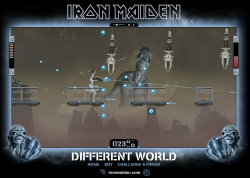 Use cursor keys and mouse to fill the screen with bullets in this platform-shoot-em-up. Collect as many of the blue power-ups as you can to upgrade your puny starting gun into a harm-producing device of chaos. Double jump if you need to, and press down to reload in quiet moments.
Use cursor keys and mouse to fill the screen with bullets in this platform-shoot-em-up. Collect as many of the blue power-ups as you can to upgrade your puny starting gun into a harm-producing device of chaos. Double jump if you need to, and press down to reload in quiet moments.
Postmortem:
After the success of the first Iron Maiden game we built, EMI comissioned a second. This is the result – a fast paced platform shoot-em-up. I had a specific goal in mind from the start, and that was to make it as over-the-top as possible. I wanted to be able to upgrade the gun tens of levels so that it goes from a weedy pop-gun to a bullet spitting death dealing mayhem device. I achieved that, but somehow a screenful of bullets still wasn’t quite as satisfying as I’d wanted. The solution was a mega-powerup that gives you all the max gun settings, at double the firing rate and with a rose-tinted death-glow over everything. That works quite well!
I think one reason the gun isn’t quite as satisfying as I’d wanted is simply that it doesn’t make much noise. We tried out various sound effects, and none really fitted. Plus, they dominated the sound-stage completely since you’re pretty much firing the entire time you’re playing.
The platforming element works remarkably well for the simplicity behind the scenes. Everything is based on a simple hit-shape that defines where the ground is, and care is taken that you can’t fall so fast as to tunnel through it. The sliding trapdoors are then just animations in that hit shape. So simple! The character can climb gentle slopes and stairs, which is essential if the player isn’t to get stuck on the slightest of objects.
The automatic, fixed pace level scrolling works well to keep the pressure on. It wouldn’t suit all games of course, but it serves its purpose well here. The only downside is that the character animation moonwalks a lot of the time!
Baddie AI is ultra simple too. They are generated at fixed positions in the game, and follow a set path. They shoot at random, but directly towards the player. This is enough in this game’s case to produce plenty of challenge, since there’s lots going on.
We struggled graphically for an explosion sequence. They always just looks pasted on top, rather than being part of the action. In the end, we settled on not having one and instead flashing the baddies brightly for a second and making them fall apart. The result works well!
Whilst this game was well received, it wasn’t anything like as widely played as the first Iron Maiden game we built. I never quite understood why, but very few portals seemed to pick up on it. I don’t think it was seeded any differently to the other game. It was still a success, but nothing like as strong as A Matter of Life and Death.
Lessons:
- If your game contains a dominant power-up, make sure it is given at designed points in the game rather than at random
- Everyone loves to fill a screen with bullets
- Don’t force your character to stop shooting back whilst he’s taking damage!
- Spend the time to make the character climb up slopes and stairs automatically. It’s well worth it for playability
- Double jumps add to the fun factor and controlability of a character
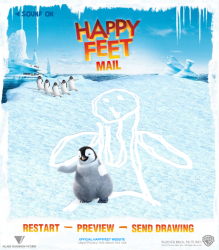 Draw out a picture then send it to your friend. They’ll see it drawn out for them by Mumble the penguin dancing across their screen!
Draw out a picture then send it to your friend. They’ll see it drawn out for them by Mumble the penguin dancing across their screen!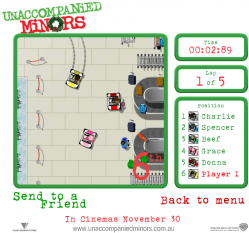 Race against the computer drivers in this all-action speed game! Use the cursor keys to steer your cart around the airport, avoiding crashing into things!
Race against the computer drivers in this all-action speed game! Use the cursor keys to steer your cart around the airport, avoiding crashing into things!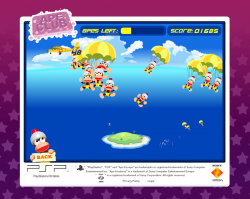 Click the falling parachuter on the main screen to go into the parachute game. It’s a simple game of clicking on falling monkeys. The trick? The monkeys fall more and more rapidly leaving you floundering to keep up. Can you find the 1000 point bonus technique for the ultimate scores?
Click the falling parachuter on the main screen to go into the parachute game. It’s a simple game of clicking on falling monkeys. The trick? The monkeys fall more and more rapidly leaving you floundering to keep up. Can you find the 1000 point bonus technique for the ultimate scores? Solve the puzzles by dropping command tiles for the robot to follow in this unique puzzle game. Compete worldwide for the fastest times over each set of levels and see your name on the highscore table!
Solve the puzzles by dropping command tiles for the robot to follow in this unique puzzle game. Compete worldwide for the fastest times over each set of levels and see your name on the highscore table!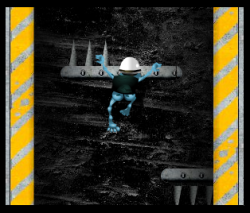 I know I know. You hate the Crazy Frog. Yep, so do I, but work is work. Besides, I did my level best to inject as little evil as possible into this banner game! In fact, it actually ended up a fairly decent little game for what was just a day or so’s work.
I know I know. You hate the Crazy Frog. Yep, so do I, but work is work. Besides, I did my level best to inject as little evil as possible into this banner game! In fact, it actually ended up a fairly decent little game for what was just a day or so’s work.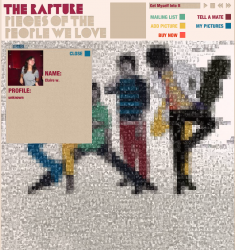
 Use your mouse to shoot the baddies and avoid the maidens in this minigame promoting the Call of Juarez computer game.
Use your mouse to shoot the baddies and avoid the maidens in this minigame promoting the Call of Juarez computer game.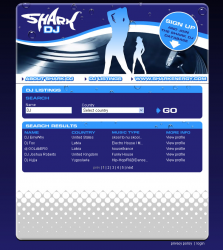 A simple database site for the Shark energy drink. You can register as a DJ and people needing DJ’s can find you!
A simple database site for the Shark energy drink. You can register as a DJ and people needing DJ’s can find you!
 RSS 2.0 full site
RSS 2.0 full site